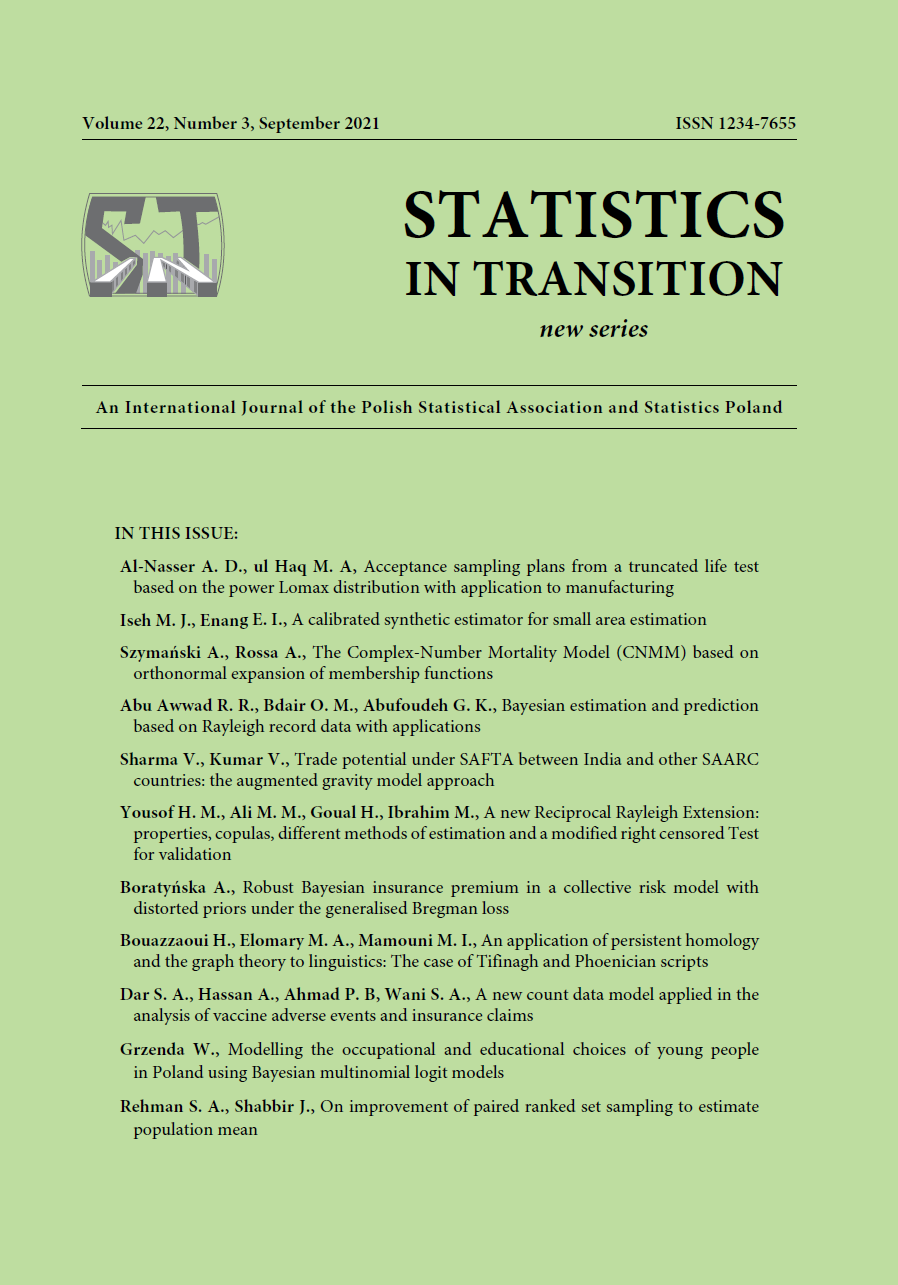ARTICLE
ABSTRACT
The paper deals with a new fuzzy version of the Lee-Carter (LC) mortality model, in which mortality rates as well as parameters of the LC model are treated as triangular fuzzy numbers. As a starting point, the fuzzy Koissi-Shapiro (KS) approach is recalled. Based on this approach, a new fuzzy mortality model – CNMM – is formulated using orthonormal expansions of the inverse exponential membership functions of the model components. The paper includes numerical findings based on a case study with the use of the new mortality model compared to the results obtained with the standard LC model.
KEYWORDS
exponential membership functions, Legendre’s polynomials, mortality modelling, orthonormal system
REFERENCES
Bongaarts, J., (2005). Long-range trends in adult mortality: Models and projection methods, Demography, 42(1), pp. 23–49.
Booth, H., Hyndman, R. J., Tickle, L., De Jong, P., (2006). Lee-Carter mortality forecasting: A multi-country comparison of variants and extensions models, Demographic Research, 15(9), pp. 289–310.
Booth, H., Maindonald, J., Smith, L., (2002). Applying Lee-Carter under conditions of variable mortality decline. Population Studies, 56 (3), 325–333.
Bozik, J. E., Bell, W. R., (1987). Forecasting Age Specific Fertility Using Principal Components, Bureau of the Census Statistical Research Division Washington D.C., CENSUS/SRD/RR-87/19, https://www.census.gov/srd/papers/pdf/rr87-19.pdf.
Brouhns, N., Denuit, M., Vermunt, J. K., (2002). A Poisson log-bilinear regression approach to the construction of projected lifetables, Insurance: Mathematics and Economics, 31(3), pp. 373–393.
Cairns, A. J. G., Blake, D., Dowd, K., (2006). A two-factor model for stochastic mortality with parameter uncertainty: Theory and calibration, Journal of Risk and Insurance, 73(4), pp. 687–718.
Currie, I. D., Durban, M., Eilers, P. H. C., (2004). Smoothing and forecasting mortality rates, Statistical Modelling, 4(4).
Danesi, I. L., Haberman, S., Millossovich, P., (2015). Forecasting mortality in subpopulations using Lee-Carter type models: A comparison, Insurance: Mathematics and Economics, 62(4), pp. 151–161.
De Jong, P., Tickle, L., (2006). Extending Lee-Carter mortality forecasting. Mathematical Population Studies, 13(1), pp. 1–18.
Diamond, P., (1988), Fuzzy least-squares, Information Sciences, 46(3), pp. 141–157. Haberman, S., Renshaw, A., (2012). Parametric mortality improvement rate modelling and projecting, Insurance: Mathematics and Economics, 50(3), pp. 309–333.
Heligman, L., Pollard, J. H., (1980). The age pattern of mortality, Journal of the Institute of Actuaries, 170, pp. 49–80.
Horiuchi, S., Coale, A. J., (1990). Age patterns of mortality for older women: An analysis using the age-specific rate of mortality change with age, Mathematical Population Studies, 2(4), 245–267.
Human Fertility Database. Max Planck Institute for Demographic Research (Germany) and Vienna Institute of Demography (Austria). Available at www.humanfertility.org.
Ishikawa, S., (1997). Fuzzy inferences by algebraic method, Fuzzy Sets and Systems, 87, pp. 181–200.
Koissi, M.-C., Shapiro, A. F., (2006). Fuzzy formulation of the Lee-Carter model for mortality forecasting, Insurance: Mathematics and Economics, 39, pp. 287–309.
Kosiński, W., Prokopowicz, P., Ślęzak, D., (2003). Ordered Fuzzy Numbers, Bull. Polish Acad. Sci. Math., 51, pp. 327–338.
Lee, R. D., Carter, L., (1992). Modeling and forecasting the time series of U.S. mortality, Journal of the American Statistical Association, 87, pp. 659–671.
Milevsky, M. A., Promislow, S. D., (2001). Mortality Derivatives and the Option to Annuitise,Insurance: Mathematics and Economics, 29, pp. 299–318
Pitacco, E., Denuit, M., Haberman, S., Olivieri, A., (2009). Modelling Longevity Dynamics for Pensions and Annnuity Business, Oxford University Press.
Prokopowicz, P., Czerniak, J., Mikołajewski, D., Apiecionek, Ł., Ślęzak, D. (eds.), (2017). Ordered Fuzzy Numbers: Definitions and Operations, Studies in Fuzziness and Soft Computing, vol. 356, Springer Open.
Renshaw, A. E., Haberman, S., (2003). Lee-Carter mortality forecasting with age specific enhancement, Insurance: Mathematics and Economics, 33(2), pp. 255–272.
Renshaw, A., Haberman, S., Hatzopoulos, P., (1996). The modelling of recent mortality trends in United Kingdom male assured lives. British Actuarial Journal, 2, pp. 449– 477.
Rossa, A., Socha, L., Szymański, A., (2011). Analiza i modelowanie umieralności w ujęciu dynamicznym (in Polish), University of Lodz Press, Łódź.
Rossa, A., Socha, L., Szymański, A., (2017). Hybrid Dynamic and Fuzzy Models of Mortality. University of Lodz Press.
Szymański, A., Rossa, A., (2014). Fuzzy mortality model based on Banach algebra, International Journal of Intelligent Technologies and Applied Statistics, 7,pp. 241– 265.
Szymański, A., Rossa, A., (2017). Improvement of fuzzy mortality model by means of algebraic methods, Statistics in Transition, 18, pp. 701–724.
Tuljapurkar, S., Li, N., Boe, C., (2000). A universal pattern of mortality decline in the G7 countries, Nature, 405, pp. 789–792.
